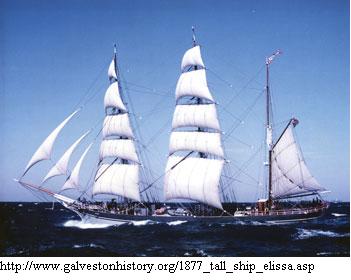Galveston County split from Brazoria, Harrisburg, and Liberty counties in 1839, and became incorporated as a county in 1839. Around 100 B.C., Indians tribes of the Karankawa, Cocos, Cujanes, Coapites, and Copanos established a small city, and maintained a hunter-gatherer lifestyle until the 1550s and 1680s with Spanish and French expeditions.
Americans settled into the county in 1827.  During the Texas Independence, Americans succeeded in annexing Texas to the United States. The county's economy thrived on the sale of cattle, cotton, molasses, sugar, and agricultural products. Large numbers of immigrants, especially Germans and other western Europeans, migrated to the county in the 1840s and 1850s.
During the Texas Independence, Americans succeeded in annexing Texas to the United States. The county's economy thrived on the sale of cattle, cotton, molasses, sugar, and agricultural products. Large numbers of immigrants, especially Germans and other western Europeans, migrated to the county in the 1840s and 1850s.
Galveston County prospered on the eve of the Civil War, owing to the use of steamships. The other minority population in the county was slaves, which became a divisive point between immigrants and Anglos. The immigrant class preferred the Union, but the county voted in favor of secession. The railroad industry helped elevate Galveston County's economy, with lines from the Southern Pacific, Santa Fe, Missouri-Kansas-Texas, International-Great Northern, Gulf and Interstate, and the St. Louis, Brownsville and Mexico station.
During the Civil War, railroads supplied the Confederacy and protected Galveston Bay. After the war, Reconstruction in Galveston County proved moderately successful compared with other states in the South. The Freedmen's Bureau opened schools throughout the county, which brought in African Americans from other parts of Texas and America.
Genealogy
- Bay Area Genealogy Study Club
- Captain Gilbreth Falls-Absolom Hooper Chapter, DAR
- Fort Virginia Point Chapter 2539, UDC
- Galveston County Genealogical Society
- George Washington Chapter, DAR
- John B. Hood Chapter, SCV Camp 50
- Palmito Ranch Chapter 2542, UDC
- Sidney Sherman Chapter (No. 02), SRT
- Texas City Ancestry Searchers Genealogical Society
- Veuve Jefferson Davis Chapter 17, UDC
- Wilson F. Wakefield Chapter 1936, UDC
Library/Archive
Historical Association/Organization
- East End Historical District Association
- Galveston Historical Foundation
- Santa Fe Area Historical Foundation
City/State/Federal Agency
Museum/Historic Site
- 1838 Jones Michel B. Menard Home
- 1859 Ashton Villa
- The Bishop's Palace
- The Cradle
- Galveston Arts Center
- Galveston County Historical Museum
- Galveston Railroad Museum
- Lone Star Flight Museum
- The Mainland Museum of Texas City
- Mardi Gras Museum
- Moody Mansion Museum
- Moody Medical Library
- Ocean Star Offshore Drilling Rig and Museum
- Powhatan House
- Samuel May Williams Home
- Texas Seaport Museum
- West Bay Common School Children's Museum
Text: http://www.tshaonline.org/handbook/online/articles/hcg02 Handbook of Texas Online, Texas State Historical Association.